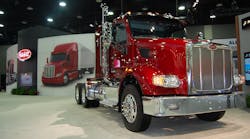LOUISVILLE, KY. “The trucking industry is coming back in a big way,” observed Robert Woodall, assistant general manager for Peterbilt Motors Company, as he took the stage at the annual Peterbilt press luncheon here today. 2014 was the best year for the industry since 2006 and, except for the driver shortage, 2015 is shaping up to be a strong year for truck sales over all, he said. The company forecasts 250,000 to 280,000 Class 8 truck sales over all in North America this year.
For Peterbilt, 2015 will be building upon the considerable successes of 2014. It was a record-setting year for the OEM which saw, among other things, a record 19.3% share of sales in the vocational market and a 30% share in the natural gas market.
Underpinning the company’s optimism for the year ahead is a long line-up of new products and services as well as enhancements to existing offerings, including a new 58-inch sleeper for the Model 579, a new set-forward axle configuration for the Model 567, the debut of new predictive cruise control technology, the launch of a new “SmartLINQ” remote diagnostics system, and the introduction of a medium-duty CNG vehicle platform, plus LNG power for Models 579 and 567.
Peterbilt also introduced the next generation of its in-dash “SmartNav” infotainment [sic] system and the expansion of its premium interiors offerings and shared news about the fuel economy gains the Model 579 EPIQ is turning in fuel efficiency gains of up to 14%. The advanced vehicle incorporates design elements from the SuperTruck project, which achieved 10.7 mpg in field testing.
58-inch sleeper for Model 579: “The 579 helped to redefine the Peterbilt product line when it was introduced,” Darrin Siver, Peterbilt general manager and PACCAR vice president told the audience. The new sleeper, which is planned to go into production during the fourth quarter, reduces weight by up to 100 pounds (versus the 80-inch sleeper) while including all of the driver amenities found on Peterbilt’s larger sleepers. It is available in both low- and mid-roof configurations to further increase its versatility to meet specific application requirements, including flatbed and tanker operations.
The new sleeper includes a full-length door to help facilitate loading personal gear and belongings from outside the truck plus full-length, integrated extenders to minimize trailer gap and improve aerodynamic efficiency. It also features a full-length mattress and abundant storage areas (including cabinets under the bunk and on the back wall) plus a television mount, refrigerator and microwave shelf.
Set-forward front axle configuration for Model 567: Available for order now with production scheduled to begin in June, the new set-forward axle configuration (SFFA) for its flagship vocational Model 567 is especially well-suited to mixer and other weight-conscious applications, according to the company.
Like the set-back axle version, the Model 567 SFFA is available in both 115- and 121-inch BBC lengths. The 115-inch BBC has a bumper to front axle distance of 29 inches and the 121-inch BBC has a bumper to front axle distance of 31 inches. These dimensions were specifically engineered to maximize maneuverability while providing the ideal wheelbase to comply with bridge law requirements.
Predictive cruise control: Anticipating and responding to changes in terrain – such as accelerating ahead of hills and coasting on the decline – Peterbilt’s new Predictive Cruise technology is designed to automatically optimize engine and transmission operation when in cruise control for maximum fuel economy. So-called “neutral coasting” utilizes the truck’s momentum to save fuel and engages the engine brake to manage downhill speeds.
“By integrating the powertrain, cruise control and satellite mapping, the vehicle automatically responds to the road ahead for up to three percent improved fuel economy,” said Siver.
According to Peterbilt chief engineer, Scott Newhouse, Predictive Cruise and neutral coast work together in five steps to maximize the truck’s kinetic energy:
- When approaching a hill, the system uses onboard maps and GPS data to accelerate to the optimal speed and adjust for the increasing road grade;
- Before the peak of the incline, the vehicle curbs its speed before proceeding downhill;
- Neutral coast engages as the truck rolls downhill;
- If necessary, the engine brake engages to avoid over speeding; and
- Cruising speed is maintained as the vehicle continues onto level terrain.
SmartLINQ remote diagnostics system: Factory installed and fully integrated, Peterbilt’s new SmartLINQ remote diagnostics system is designed to provide customers with real-time, at-a-glance fleet health to maximize uptime, keep deliveries on schedule and manage service events.
Newhouse explained how SmartLINQ works: “When a diagnostic code is generated, the severity of the code is analyzed. There are three general areas the diagnostic codes will fall into: service advised; service immediately; and stop engine,” said Newhouse. “Diagnostic code notifications will be sent via e-mail to whomever the customer designates with all of the information a fleet manager needs to get a vehicle serviced quickly to maximize uptime. Or, in the event of more severe service issues, make arrangements to get a load hauled by another truck to keep deliveries on-time.”
All vehicles equipped with SmartLINQ can also be monitored in real time through a web-based portal customized for the customer. The at-a-glance interface includes a map of North America with each unit represented by an icon color coded to vehicle health: green for no events; yellow for diagnostic codes that need attention soon; and red for diagnostic code events that require immediate action. There are also icons to indicate related information, such as Peterbilt dealer locations.
“In addition to the map display, fleet managers have access to a wealth of detailed, sortable data that is easily integrated with many other maintenance management platforms,” said Newhouse. SmartLINQ-equipped trucks include a dedicated modem, antenna, access to the portal and the complimentary, two-year subscription. Additionally, SmartLINQ is compatible with any telematics system.
The system is scheduled to begin production in June and will be standard on all Peterbilt trucks equipped with a PACCAR MX-13 engine. It includes a complimentary two-year subscription. SmartLINQ will be expanded to other truck systems and platforms in the months ahead.
Natural gas: Peterbilt, which has the lion’s share of the natural gas marketplace, also introduced two new medium-duty vehicles powered by compressed natural gas (CNG)—the Model 337 and Model 348. Both vehicles are now in production and can be ordered configured as trucks or tractors.
“The CNG Models 337 and 348 give Peterbilt the industry’s most competitive portfolio of natural-gas vehicles,” Newhouse said. “The dimensions provide a BBC two inches shorter than any competitive model and a cab height that is 2.5 inches lower.” The optimized spec, including steering geometry that provides up to a 50 degree turning angle, provides improved maneuverability in congested city and jobsite operations.
Both the Models 348 and 337 are powered by the Cummins Westport ISL-G with 320 horsepower and 1,000 lb.-ft. of torque. The engine complies with EPA 2010, 2013 and CARB regulations.
Liquid natural gas (LNG) has also been added as a power option for Peterbilt Models 579 and 567, introduced earlier in CNG configurations. Both are available as daycabs; production is scheduled to begin in June.
During the question and answer session at the end of the press event, Siver was asked about the impact of lower diesel prices on the demand for natural gas-powered trucks. The price of oil is cyclical,” he noted. Fleets are getting into natural gas for various reasons, including cost stability and for “green” requirements/wishes. About five percent of the market is now natural gas. Could it grow to ten percent? Probably. Could it grow to 25 percent? Probably not. But remember that trucks used to be powered mostly by gasoline, not diesel.
Next generation SmartNav: Peterbilt also introduced the next generation of its in-dash SmartNav “infotainment” system that features an expanded array of virtual gauges, auto-activated safety cameras, improved hands-free calling and the capability to provide real-time traffic and fuel price information.
One of the key improvements to the new SmartNav system is its ability to be customized with approved applications developed by Peterbilt, PACCAR or third parties,” said Newhouse. “For instance, future functionality could include integration with reefer trailers or truck bodies to provide operational data, like reefer temperature. SmartNav’s new flexible architecture allows it to be updated quickly with additional features and capabilities…Additionally, it is telematics-enabled to communicate with systems such as electronic logbooks and other fleet management platforms.”
Premium interiors: The company also introduced the addition of the Platinum Graphite Interior Package to its line of premium cab and sleeper trim options for the Models 579 and 567 in daycab configurations or when equipped with a 72-inch or 80-inch sleeper.
The new interior, intended to help fleets attract and retain good drivers, features black leather seats and blackwood trim on dash panels, door panels, storage header area and sleeper cabinets among other fit and finish elements.
Autonomous vehicles: Peterbilt also shared a look ahead at autonomous vehicles, noting that several technologies are making the vision possible, including lane keeping, traffic assist (including automatic braking), GPS navigation and platooning. During the question and answer session, Siver noted that driverless vehicles are still “a long way off” for long-haul operations. “The biggest challenge is the comfort of the public with [the concept],” he said.
The first use of autonomous vehicles will probably be in vocational operations or in contained areas such as yards or docks, Siver added. A video of a test truck did just that: drove thorough a yard, stopped to avoid a pedestrian in its path and parked itself. Not bad.



